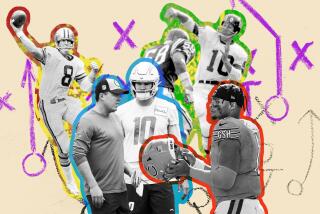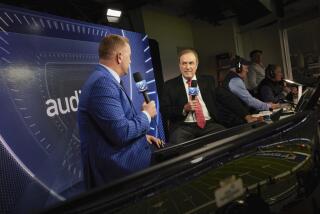FM Radio Plays a Growing Role as Pipeline for Data
- Share via
WASHINGTON — Beginning this fall, selected National Football League fans in Los Angeles and as many as 20 other cities will be able to play along with the quarterback, anticipating game strategy in their living rooms before plays are called on the field.
These armchair quarterbacks will receive game information over a previously unused part of the FM radio band. During the game, they’ll be able to record their own strategies--”pass deep left,” for example--on a small hand-held computer. Then, a special FM receiver will transmit the quarterback’s actual call.
After the game, play selections can be phoned into a central computer, which will tell players how their guesses compared with those of other armchair strategists.
Innovative Applications
“It’s basically cable television without cable,” said Patrick Downs, president of NTN Communications in Carlsbad, Calif., which hopes to take its football strategy game nationwide in 1986.
Downs’ game is but one of a growing number of innovative applications emerging for a little-known part of the public airwaves--the largely unused portion of every FM radio station’s broadcast band.
For more than 20 years, some FM stations have used their excess capacity to broadcast background music such as Muzak into elevators and restaurants and to offer limited services for select groups: reading services for the blind, medical news for doctors, livestock prices for commodity brokers.
Until April, 1973, the Federal Communications Commission maintained strict guidelines for the use of this part of the FM band. But then the FCC relaxed its regulations, greatly increasing the availability of the unused part of each FM station’s broadcast capacity and expanding the kinds of information that could be carried.
Private entrepreneurs are beginning to take advantage of the expansion. Already, some companies ride piggyback on regular FM stations to activate personal paging devices; others distribute pricing information to their retail outlets. The FM spectrum is becoming an alternative to telephone lines--and often a cheaper alternative--for anyone who wants to transmit information of almost any kind, from stock market quotations to weather reports.
“Radio stations are changing,” said Alan A. Reiter, editor of Subcarrier Communications, a Washington-based industry newsletter. “They are becoming information pipelines.”
All this is possible because each FM station occupies not just a point on the radio dial but a range; a station at 91.5 megahertz, for example, has authority to operate from about 91.4 to 91.6 MHz. But stations do not need that entire range to serve up their standard fare of rock music or news or golden oldies.
On the unused part of their little slice of the FM radio band, stations can transmit additional information--information that does not register on ordinary FM radios and can be picked up only by special receivers.
Need Special Receivers
In the technical jargon, the unused segment of each FM station’s piece of the radio spectrum is called a “subcarrier.” Typically, FM stations make a little money on the side by renting out their subcarriers, much as homeowners sometimes rent rooms. In the FM context, the renters feed specialized programming or information to subscribers, who get the service only by leasing special receivers.
Today, about 1,000 of the 4,500 FM stations lease their subcarriers and the number is growing. Broadcasting experts estimate the current subcarrier market at about $20 million a year and predict that it will grow to $50 million by 1987 and ultimately as high as $100 million.
“It’s a very effective way to communicate with large numbers of people in a very inexpensive way,” Downs of NTN Communications said.
For the privilege of piggybacking on an FM station’s little share of the broadcast spectrum, subcarrier operators typically pay $1,000 to $10,000 a month, depending on the station’s location and power. That’s markedly less expensive than buying a radio station, especially in large cities, where stations have million-dollar price tags. Operators of FM subcarriers become telecommunications entrepreneurs without needing FCC licenses.
“One of the most widely heard questions in the broadcasting industry today is: ‘How much is my subcarrier worth?’ ” one industry expert said.
Muzak Was Pioneer
One of the pioneer subcarriers was Muzak, which was started in 1934 and now goes to 185 cities around the country, mostly through leases with individual FM stations. Muzak, the largest subcarrier network, is owned by Westinghouse Broadcasting.
Physicians Radio Network, begun in 1974, provides a 24-hour “audio newsletter” to 73,000 doctors in 70 cities. The one-hour broadcast, repeated continually and interspersed with drug industry advertising, is sent via satellite from Stamford, Conn., to FM subcarriers that carry the newsletter to subscribers.
Thanks to the FCC’s 1983 deregulation, the most dramatic opportunities for FM subcarriers are in data transmission.
“The range of applications is fairly limited compared to the overall data communications market, but in certain niches it’s very effective,” said Dennis P. Waters of Waters Information Services in Binghamton, N.Y., which produces publications on data communications.
Mutual Satellite Services, a subsidiary of the Mutual Broadcasting System, is establishing a national subcarrier network to operate in major cities across the country by summer. The company has designed a receiver and printer for its system, which is intended to enable users to disseminate written information quickly.
On May 7, Mutual announced that Dow Jones & Co. had signed a letter of intent to use Mutual’s subcarrier network to distribute its Dow Jones News Service. Dow Jones will begin trial service in New York this month and hopes to send its news service to brokers, banks and other financial institutions in major cities by the end of September.
Seek Alternatives
Until now, Dow Jones has been relying on telephone lines to transmit its news service. But recent FCC-approved rate increases in the American Telephone & Telegraph Co.’s private dedicated lines are forcing businesses to consider less expensive alternatives.
“It’s a very specialized kind of bypass” of the telephone system, said Charles Jackson, a communications consultant in Washington. “It’s another form of competition for the telephone company.”
Similarly, Statler Bros. and Lucky Stores, two California supermarket chains, use an FM subcarrier instead of a more expensive network of telephone lines to notify their retail outlets of price changes and delivery schedules.
Weather forecasts represent another form of information traveling more frequently over FM subcarriers. In Arkansas, the National Weather Service transmits continuous forecasts to subscribers who pay about $30 a month, compared with several hundred dollars a month that telephone lines would cost. For its access to the airwaves, the weather service pays an FM station about $4,000 a month, less than half the cost of telephone transmissions.
In Vermont, the Greater Resort Area Information Link provides ski conditions to hundreds of hotels and condominiums over a subcarrier leased from WNCS-FM in Montpelier. On properly equipped television sets, the information is displayed on an otherwise blank channel.
Organizing Network
More and more companies are using FM subcarriers to provide paging services. DiversiCom, a division of American Diversified Corp. in Costa Mesa, is organizing a subcarrier network of 75 FM stations into a nationwide paging and data-distribution service. A telephone call to someone in the paging network would trigger a satellite-directed FM subcarrier signal that would deliver a message to the digital readout screen on a personal paging device.
“We feel we have a jump on the market,” DiversiCom marketing director Fritz Mehrer said. He estimates that his company is two years ahead of other efforts to organize nationwide paging systems using frequencies outside the FM range.
AT&E; Laboratories in Portland, Ore., is working on a wristwatch subcarrier paging device. And in San Bernardino, a publishing company called American Trucker Communications is planning to market a paging device that will allow truck drivers to receive messages from dispatchers without stopping to use a telephone. In this low-cost substitute for radio communication, messages will be transmitted by FM subcarriers to special receivers carried by the truckers.
In fact, FM subcarriers lend themselves nicely to use by all kinds of persons on the move. Blaupunkt, the German car radio maker, offers Automatic Radio Information Service, which broadcasts traffic reports over the subcarriers of a dozen FM stations. A modified car radio is required to receive the signals.
In El Paso, Tex., bus passengers have been listening to music provided by the National Transit Radio Network in Kansas City, Mo.--a sort of Muzak on wheels. At least a dozen other cities are considering the service.
Linked to Computers
Links are being forged between FM subcarriers and personal computers. Several companies, including Dataspeed of San Mateo, Calif., and Telemet America of Alexandria, Va., offer portable stock quotation devices the size of pocket calculators that can been hooked into IBM-compatible personal computers.
Susan Horty of Telemet said the company has 10,000 subscribers for its $399 Pocket Quote Pro, which provides up-to-the-minute data on as many as 320 securities as well as news briefs. Receivers can even be programmed to alert subscribers when particular stocks reach designated highs or lows. Subscribers pay a minimum annual fee of $299 for the service.
Meanwhile, Electronic Publishing Systems of Mountain View, Calif., will test the transmission of games and educational and financial programs to personal computers.
Although subcarriers may seem to provide a source of easy money for FM stations, they have some drawbacks. Some large stations consider the revenues insufficient for the amount of work involved in leasing subcarriers. Besides, subcarriers can interfere slightly with the volume and quality of the basic FM broadcasts.
But Lyle Henry, the chief engineer at KIQQ-FM in Hollywood, said this problem can be overcome. “As people realize that this is not a big negative and that their competitors are doing it,” he said, “they’re going to get in and get a few extra bucks.”
More to Read
Go beyond the scoreboard
Get the latest on L.A.'s teams in the daily Sports Report newsletter.
You may occasionally receive promotional content from the Los Angeles Times.










